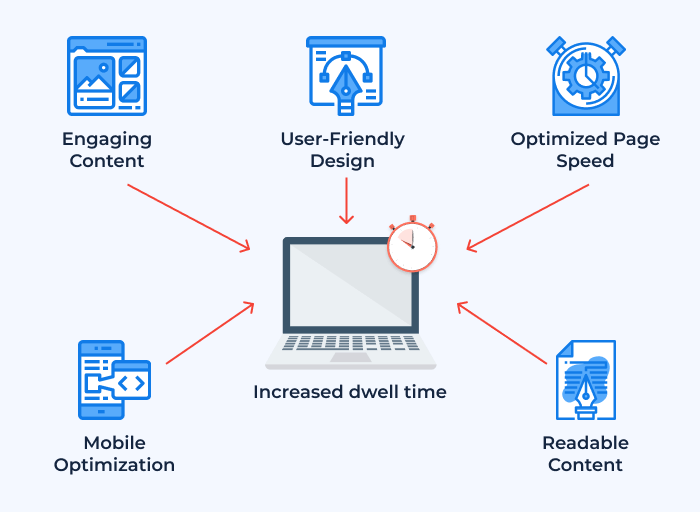Uncover the mysterious world of dwell time and how it impacts your online presence, engagement, and overall success. Explore now!

Image courtesy of via DALL-E 3
Table of Contents
Introduction to Dwell Time
Have you ever wondered how long you stay on a website before clicking away? Well, that’s what we call “dwell time.” Just like how we linger in places we enjoy in real life, dwell time measures the amount of time someone spends on a website before leaving. Let’s take a closer look at this interesting concept!
What is Dwell Time?
Dwell time is the time that starts ticking the moment you click on a website link and stops when you click the back button or exit the webpage. It’s like a digital stopwatch measuring how long you hang around on a website before deciding to leave.
Why It Matters
For website owners, dwell time is like a little window into the minds of their visitors. It helps them understand if people are interested in what they see on their websites. Think of it as a signal that shows whether the website is engaging and captivating enough to hold your attention.
How Dwell Time is Measured
Measuring dwell time is like keeping track of how long you stay at a party before deciding to leave. Just like at a party, when you click on a website link, the clock starts ticking until you decide to leave by clicking the back button or closing the tab.
Tracking Tools
Website owners have special tools, like Google Analytics, that help them see how much time visitors spend on their site. These tools keep a close eye on how long people hang out on different web pages.
Understanding Metrics
Metrics may sound like a tricky word, but they’re just numbers that help us understand things better. In this case, they help website owners figure out how long visitors stayed and what parts of the website they liked the most. It’s like a fun puzzle that shows what keeps people interested!
Factors Influencing Dwell Time
When it comes to how long someone decides to stay on a website, several factors can play a crucial role in influencing their dwell time. Let’s explore these key elements that website owners should consider to keep visitors engaged and interested.

Image courtesy of www.geeksforgeeks.org via Google Images
Website Design
One significant factor that can impact dwell time is the design of a website. Websites that are visually appealing, easy to navigate, and clutter-free tend to attract and retain visitors for longer periods. A clean and well-organized layout can make it more enjoyable for users to explore the site and find the information they are looking for.
Content Quality
The quality of the content on a website is another vital aspect that can influence dwell time. Engaging, informative, and relevant content not only captures the attention of visitors but also encourages them to stay longer. Interesting articles, helpful tips, and visually appealing images can keep users engrossed and eager to explore more of what the site has to offer.
Usability
Usability plays a significant role in determining how long visitors choose to stay on a website. Websites that are easy to navigate, with clear menu options and intuitive user interfaces, are more likely to keep users engaged. When visitors can quickly find what they are looking for and move seamlessly through the site, they are less likely to become frustrated and leave prematurely.
Ways to Increase Dwell Time
Increasing dwell time on a website is important for keeping visitors engaged and interested in the content you have to offer. By implementing some simple strategies, you can encourage visitors to spend more time exploring your site. Here are some effective ways to increase dwell time:
Creating Engaging Content
One of the best ways to keep visitors on your website is by providing them with engaging and valuable content. Make sure your articles, videos, or images are interesting, informative, and relevant to your target audience. Use captivating headlines and clear, concise language to grab and hold their attention.
Easy Navigation
Ensure that your website is easy to navigate so that visitors can find what they’re looking for quickly and easily. Use clear menu options, logical page layouts, and internal links to guide them through your site. A user-friendly experience will encourage visitors to explore more of your content before leaving.
Interactive Elements
Add interactive elements to your website to make it more engaging and fun for visitors. Include features like videos, quizzes, polls, or games to keep them entertained and encourage interaction. Interactive elements can help increase dwell time by providing an immersive and enjoyable experience for your visitors.
Dwell Time vs. Bounce Rate
In the world of websites and internet browsing, two important metrics that website owners pay close attention to are dwell time and bounce rate. While both metrics provide valuable insights into user behavior, they focus on different aspects of website engagement.
Image courtesy of www.researchgate.net via Google Images
Definition of Bounce Rate
Let’s start by understanding bounce rate. Bounce rate is the percentage of visitors who leave a website after only viewing a single page. It indicates the number of people who land on a page and then decide to leave without interacting further with the site. A high bounce rate can suggest that visitors didn’t find what they were looking for or that the page didn’t capture their interest enough to explore further.
Comparing Both Metrics
On the other hand, dwell time focuses on the duration of time a visitor spends on a website. It measures the time from when a user first clicks on a website link to when they navigate away. While dwell time gives insight into how long visitors engage with a site’s content, bounce rate highlights the number of pages viewed during a session.
For instance, imagine you visit a website and immediately leave without interacting with any other pages—that would contribute to a high bounce rate. However, if you spend several minutes reading through multiple pages on a different site, your dwell time for that site would be longer.
Real-World Examples of Dwell Time
Have you ever found yourself spending hours watching funny cat videos on YouTube or delving deep into the history of dinosaurs on Wikipedia? These are examples of popular websites where people tend to spend a lot of time. The captivating content and endless array of videos or articles keep users engaged, leading to longer dwell times.
Personal Experience
Imagine stumbling upon a blog with fascinating stories that you just can’t stop reading, or discovering a website filled with cool games that you can’t seem to get enough of. In these cases, your dwell time reflects your interest and enjoyment of the content. Personal experiences like these demonstrate how dwell time can vary based on what captures your attention and keeps you engaged.
Common Misconceptions About Dwell Time
In this section, we will debunk common myths and clarify misunderstandings about what dwell time really means.

Image courtesy of cyberhoot.com via Google Images
More Dwell Time Equals Better
One common misconception about dwell time is that the longer someone stays on a website, the better the website must be. While it is true that longer dwell times can indicate that visitors find the content engaging, it is not always the case. Sometimes, users may spend a long time on a website because they are struggling to find the information they need or because the website has confusing navigation.
All Users Are the Same
Another misconception is that all users will have the same dwell time when visiting a website. In reality, dwell time can vary greatly depending on the user’s level of interest in the content, their familiarity with the topic, and even their browsing habits. Some users may quickly find what they are looking for and leave, while others may explore multiple pages and spend a significant amount of time on the site.
Tips for Parents and Kids
When it comes to browsing the internet, safety should always be a top priority. Teach your kids to only visit websites that you trust and that are age-appropriate. Make sure they understand not to share personal information online and to be cautious when clicking on links or downloading files. Encourage open communication so they feel comfortable talking to you about any strange or uncomfortable online experiences.
Time Management
It’s easy to get lost in the vast world of the internet, but it’s important for kids to strike a balance between screen time and other activities. Set limits on how much time they can spend online each day and encourage them to explore different hobbies and interests offline. Help them learn the value of time management and prioritizing their activities for a well-rounded and fulfilling lifestyle.
Conclusion
In this blog post, we’ve delved into the concept of dwell time and explored why it matters for website owners. Remember, dwell time is the amount of time someone spends on a website before leaving, much like how we linger in places we enjoy in real life.

Image courtesy of sitechecker.pro via Google Images
Recap of Dwell Time
Dwell time is measured from the moment a user clicks on a website link to when they click the back button or exit the site. It is a crucial metric that indicates whether visitors find the content engaging or not.
Encouragement to Explore
As an 11-year-old reader, you can also pay attention to your own dwell time on websites and think about why you stay on certain sites. Is it the fun games, interesting articles, or cool videos that captivate you?
By creating engaging content, ensuring easy navigation, and incorporating interactive elements, website owners can work on increasing their dwell time. Remember, a longer dwell time indicates that visitors are enjoying the website, so keep exploring and discovering new sites that capture your interest!
Frequently Asked Questions (FAQs)
What Affects My Dwell Time?
Dwell time can be influenced by several factors, such as the design of the website, the quality of the content, and how user-friendly the website is. A visually appealing and easy-to-navigate site with captivating content is likely to keep visitors engaged for longer periods. On the other hand, websites with cluttered layouts, uninteresting content, or complicated navigation may lead to quicker exits.
Can I Improve My Website’s Dwell Time?
Absolutely! You can enhance your website’s dwell time by creating engaging and informative content that captures the interest of your visitors. Additionally, ensuring that your website is easy to navigate and incorporating interactive elements like videos, quizzes, or games can also help increase the time visitors spend on your site. By providing a positive user experience, you can encourage visitors to explore more of your content and ultimately boost your dwell time.
Is Dwell Time Important for All Websites?
While dwell time can provide valuable insights into user engagement and interest for many websites, its significance may vary depending on the specific goals and nature of the website. For example, e-commerce sites may place more emphasis on conversion rates and purchases rather than dwell time alone. However, regardless of the website’s purpose, monitoring and optimizing dwell time can still offer useful feedback on how visitors interact with your content and website overall.







